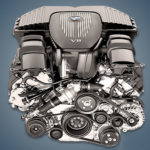The Japanese company has been assembling the 2.0-liter Suzuki J20A gasoline engine since 1998, and the Grand Vitara with such a unit is still being sold in some emerging markets. There are two versions of the motor with different cylinder heads, camshafts, intake manifold.
Engines of the J-series: J18A, J20A, J20B, J23A, J24B.
In 1998, a 2.0-liter engine appeared under the J20 index on the first generation of the Grand Vitara and it was a unit with distributed fuel injection that was quite typical for its time. It also has an aluminum cylinder block, cast-iron liners and an open cooling jacket, an aluminum 16-valve cylinder head not equipped with hydraulic lifters, a timing chain drive. The motor is very simple in design and it does not have a variable valve timing system.
In 2001, the updated J20A engine appeared on the Suzuki Aerio, the American version of Liana, but the engine gained popularity when it began to be installed on the second generation Grand Vitara. Thanks to the new cylinder head and increased compression ratio, its power has increased from 128 to 145 hp. Even American versions of the engine usually had hydraulic valve clearance compensators.
Specifications
| Production years | since 1998 |
| Displacement, cc | 1995 |
| Fuel system | distributed injection |
| Power output, hp | 128 – 145 |
| Torque output, Nm | 174 – 190 |
| Cylinder block | aluminum R4 |
| Block head | aluminum 16v |
| Cylinder bore, mm | 84 |
| Piston stroke, mm | 90 |
| Compression ratio | 9.3 – 10.5 |
| Hydraulic lifters | no |
| Timing drive | chain |
| Phase regulator | no |
| Turbocharging | no |
| Recommended engine oil | 5W-30, 5W-40 |
| Engine oil capacity, liter | 4.7 |
| Fuel type | petrol |
| Euro standards | EURO 4/5 |
| Fuel consumption, L/100 km (for Suzuki Grand Vitara 2007) — city — highway — combined |
11.6 7.6 9.1 |
| Engine lifespan, km | ~300 000 |
The engine was installed on:
- Suzuki Aerio 1 (ER) in 2001 – 2007;
- Suzuki SX4 1 (GY) in 2006 – 2010;
- Suzuki Escudo 2 (FT) in 1998 – 2005; Escudo 3 (JT) in 2005 – 2017;
- Suzuki Grand Vitara 1 (FT) in 1998 – 2005; Grand Vitara 2 (JT) since 2005.
Disadvantages of the Suzuki J20A engine
- Most often, on specialized forums, the owners of such engines complain about the oil burner. The reason is usually in hardened valve stem seals, but if replacing them does not help, then it means that it is time to overhaul the motor with the bore of the sleeves to the repair size.
- This motor is quite demanding on the quality of the oil and especially on the procedure for replacing it, and the owners of older cars often save on fuels and lubricants and this often leads to crankshaft liners turning and then the wedge of your unit.
- In this engine, the timing drive consists of three thin chains with a low resource, sometimes they stretch and require replacement even up to 100 – 120 thousand kilometers. However, due to saving on oil, hydraulic chain tensioners can fail earlier.
- Like any aluminum engine, it is very afraid of overheating, it often leads to the cylinder head. Also, the intake manifold is quickly clogged and the crankshaft oil seals are constantly flowing. And do not forget to check the condition of the candles and valve clearances every 30,000 km.







Why does the crank shaft journal carrying the oil pump chain scoring the main bearings after engine rebuild? Could it be the oil pump load or does it require a different torque setting?